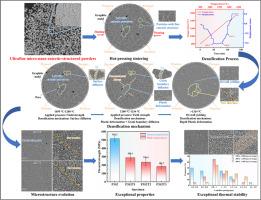微纳共晶结构粉体热压烧结大尺寸Al2O3/YAG/ZrO2共晶陶瓷致密化机理及显微组织演变
IF 14.3
1区 材料科学
Q1 MATERIALS SCIENCE, MULTIDISCIPLINARY
引用次数: 0
摘要
本研究通过制作具有超高密度(99.83%)和保留亚微米共晶结构(间距0.408 μm)的大块Al2O3/YAG/ZrO2陶瓷(120 mm × 10 mm),解决了长期存在的大氧化物共晶陶瓷致密化和微观组织粗化之间的平衡问题。这一成果是通过一种集成的创新方法实现的,该方法结合了以300 μm/s(间隔0.141 μm)激光浮区熔融合成的超细微纳粉末,超声波湿法筛分用于界面净化,以及在1550°C(比常规温度低150°C)的低温热压烧结,通过塑性主导的机制协同辅助短程界面扩散,在60 MPa压力下在45分钟内实现了完全致密化。这种由塑性驱动的工艺,在1200-1550°C激活,产生超薄的重新连接界面(0.7 μm厚度),同时避免晶粒变粗。在室温下,烧结陶瓷的维氏硬度为16.25±0.46 GPa,断裂韧性为4.57±0.81 MPa m1/2,抗弯强度为516.3±34.6 MPa,明显优于普通烧结共晶陶瓷。在1200℃时,通过抑制晶格膨胀和微纳塑性,材料的高温强度保持在290.1±33.6 MPa。值得注意的是,在1400℃下暴露500 h后,受约束的显微组织粗化(共晶间距从0.408扩展到1.097 μm, Al2O3/ZrO2/YAG相限制在0.651/0.406/0.434 μm)导致硬度(16.74±0.37 GPa)和可用断裂韧性(3.09±0.17 MPa m1/2)增强,并通过界面钉钉效应表现出优异的热稳定性。这项工作建立了一个可扩展的塑性低温烧结策略,用于制造在极端环境下具有高性能的大型结构部件。本文章由计算机程序翻译,如有差异,请以英文原文为准。

Densification mechanism and microstructure evolution of large-sized Al2O3/YAG/ZrO2 eutectic ceramics by hot-pressing sintering based on micro-nano eutectic-structured powders
This study resolved the long-standing trade-off between densification and microstructural coarsening in large oxide eutectic ceramics by fabricating bulk Al2O3/YAG/ZrO2 ceramics (120 mm × 10 mm) with an ultra-high density (99.83%) and retained submicron eutectic structure (spacing 0.408 μm). This achievement was enabled by an integrated innovative approach combining ultrafine micro-nano powders synthesized via laser floating zone melting at 300 μm/s (spacing 0.141 μm), ultrasonic wet sieving for interfacial purification, and low-temperature hot-pressing sintering at 1550°C (150°C below conventional temperatures), full densification within 45 min under 60 MPa pressure is enabled through a plasticity-dominated mechanism synergistically assisted by short-range interfacial diffusion. This plasticity-driven process, activated at 1200–1550°C yielded ultrathin reconnected interfaces (0.7 μm thickness) while avoiding grain coarsening. The sintered ceramics exhibited exceptional properties: Vickers hardness 16.25 ± 0.46 GPa, fracture toughness 4.57 ± 0.81 MPa m1/2, and flexural strength 516.3 ± 34.6 MPa at room temperature, significantly surpassing conventional sintered eutectic counterparts. High-temperature strength was retained at 290.1 ± 33.6 MPa at 1200°C through suppressed lattice expansion and micro-nano plasticity. Remarkably, after 500 h exposure at 1400°C, constrained microstructural coarsening (eutectic spacing evolved from 0.408 to 1.097 μm; Al2O3/ZrO2/YAG phases limited to 0.651/0.406/0.434 μm) resulted in enhanced hardness (16.74 ± 0.37 GPa) and serviceable fracture toughness (3.09 ± 0.17 MPa m1/2), demonstrating superior thermal stability via interface pinning effects. This work establishes a scalable plasticity-enabled low-temperature sintering strategy for manufacturing large-sized structural components with high performance in extreme environments.
求助全文
通过发布文献求助,成功后即可免费获取论文全文。
去求助
来源期刊

Journal of Materials Science & Technology
工程技术-材料科学:综合
CiteScore
20.00
自引率
11.00%
发文量
995
审稿时长
13 days
期刊介绍:
Journal of Materials Science & Technology strives to promote global collaboration in the field of materials science and technology. It primarily publishes original research papers, invited review articles, letters, research notes, and summaries of scientific achievements. The journal covers a wide range of materials science and technology topics, including metallic materials, inorganic nonmetallic materials, and composite materials.
 求助内容:
求助内容: 应助结果提醒方式:
应助结果提醒方式:


